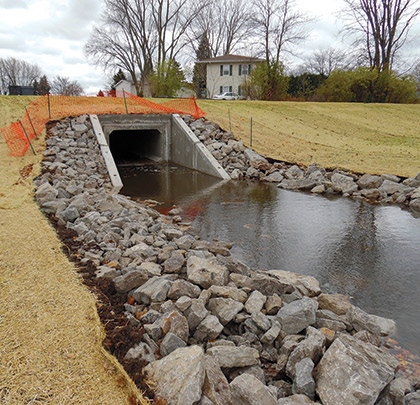Water is everywhere. In fact, it covers more than 70 percent of Earth’s surface, serving as the backbone of all life forms—plants, animals, and humans alike (water.usgs.gov/edu/earthhowmuch.html). Without water, life as we know it would cease to exist and the world would look much different than it does today.
Still, despite how important water is to all living things, in excess it can be very destructive. For example, heavy rains can lead to flooding and place stress on inadequate infrastructure systems. Though the resulting damage can be devastating, with the right stormwater system in place, it can also be avoided.
In Oshkosh, Wisconsin, city officials were in need of a solution that could replace an insufficient storm system near the intersection of 9th Avenue and Washburn Street. The group envisioned a large detention basin for the water with an accompanying structure designed to effectively move stormwater to the location.
The solution is a precast concrete system made from numerous components that work together to better manage stormwater in the area.
TEAM EFFORT
To install the updated storm water system,the city partnered with general contractor James Peterson Sons (JPS) of Medford, Wisconsin. While some components of the project originally called for cast-in-place concrete, JPS recognized that opting for a complete precast solution had the potential to provide a variety of benefits to the parties involved.
As a result, JPS contacted Wieser Concrete Products of Portage, Wisconsin, to assist in making the change. The companies, which had collaborated before, worked closely together to ensure success.
“We prepared and reviewed detailed shop drawings with JPS to make sure they could handle the section weights of the precast and that the site would allow it,” says Mark Wieser, vice president for Wieser Concrete. “JPS also let us know right after they were awarded the job when they would need the products, so we were able to schedule accordingly and have the precast produced and delivered when needed.”
By combining their efforts, Wieser and JPS were able to successfully convince city officials that the solution could provide the strength required for the project while also offering additional advantages.
TOTAL CONTROL
Wieser Concrete manufactured many different types of precast for the upgraded stormwater system, including 33 sections of 25,000-pound, 8-foot-by-5-foot box culvert, an 11-foot square by 9-foot tall junction chamber, and a 13-foot wide by 20-foot long by 10-foot high outfall. Both the junction chamber and outfall were produced in two pieces. This split the weight, allowing for easier delivery. Each section of the junction chamber weighed 48,000 pounds, while the outfall pieces were 46,000 pounds and 28,500 pounds.
According to Doug Johnson, superintendent with JPS, going with the precast solution saved time and money.
“The biggest advantage was the timeframe,” he says. “To have someone come in and pour this in place would have taken considerably more time than using precast. We were able to place the junction chamber in about 3 hours. It would have taken 3 to 4 weeks with cast-in-place.”
Johnson also explained that because of the use of precast, his crew was able to cut the project time in half, enabling them to complete all of the work in just 2½ months. And because crews didn’t have to rely on cast-in-place concrete, they set the pace.
“With precast, we are in total control of the project,” Johnson says. “We didn’t have to wait for the concrete guy to come out, put his forms in, and pour his stuff. We were in control and did things on our time, when they needed to be done.”
Wieser agreed with Johnson, noting the additional benefit of removing a safety hazard by limiting the amount of time crews required an open excavation.
A BETTER SOLUTION
All of the precast components of the project work in tandem to ensure stormwater is efficiently transported in the area. When rain falls, water enters a massive, 60-inch pipe before arriving at the junction chamber. From the junction chamber, it passes through the 5-foot-by-8-foot box culvert, then dumps into a riprap channel. Ultimately, the water then reaches the detention pond.
By convincing city officials to select precast, installing the junction chamber—a critical component of the system—was made easier for JPS.
“The junction chamber and an outlet structure were supposed to be pour-in-place, but Wieser was able to design a lighter product—basically, a better product—and get it to pass through the city,” Johnson notes.
Thanks to the close work between the two companies, both Wieser and Johnson share they are pleased with the performance of the structures used and the project as a whole.
WATER WORLD
As long as humans continue to live on a planet that consists mostly of water, it will serve a dual purpose as a source of life and—when in excess—potential danger. Thankfully, general contractors and precast concrete manufacturers can work together to develop effective stormwater management solutions that keep water in check. In doing so, infrastructure systems can be preserved and human lives can be protected, all while reducing costs and saving time spent on the jobsite. ■
For More Information: Mason Nichols is NPCA’s external communication and marketing manager. He is responsible for an array of communication and marketing initiatives at NPCA, including managing the association’s social media accounts, producing the Precast Digest e-newsletter and developing articles for both of NPCA’s publications. Mason also handles the day-to-day upkeep of NPCA’s marketing initiatives and serves as the managing editor for Precast Solutions magazine.
Editor’s Note: If you would like to partner with a precast concrete manufacturer in your area for your next project, you can easily locate one by using the “Find Precast Products & Supplies” feature on the National Precast Concrete Association’s website. Advanced search options allow you to find precast manufacturers by product type, state, postal code, and more. Visit precast.org/find to get started.
_________________________________________________________________________
Modern Contractor Solutions – December 2015
Did you enjoy this article?
Subscribe to the FREE Digital Edition of Modern Contractor Solutions magazine.

Calming the Water


